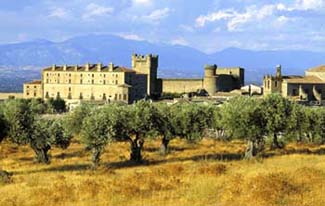
Photos courtesy of Parador de Oropesa
Plaza Palacio, 1
45560 Oropesa (Toledo)
Tel: ++34 925 43 00 00
Fax: ++34 925 43 07 77
Official parador website
Reserve with Booking.com
48 rooms
Double rooms: 75–218 euros
Single rooms: 80% of double
room rate
Rates include tax. Breakfast extra.
Free Wi-Fi
Open: all year
Oropesa is 117 km west of Toledo off the National Road V. The 4-lane highway is good, but traveling through Talavera de la Reina is slow. Oropesa has train service.
On site: seasonal swimming
pool; exploration of parador castle
Nearby: drives along the “embroidery route” and the “pottery route”
Sitting in the foothills of the Sierra de Gredos, this majestic castle is one of the oldest paradors in Spain. It commands an extensive view encompassing snowcapped peaks, olive trees, and the whitewashed village of Oropesa.
Driving through the massive stone archway to the castle entrance, you’re surrounded by ancient walls and towers. Inside, you're immersed in more medieval ambience, with tile floors, high ceilings supported by wood beams, stone chimneys, and old chests.
Spacious guest rooms are appointed with thick throw rugs, contemporary furniture, folk art, and enormous tiled bathrooms. All rooms are air-conditioned—a welcome relief if you're here during the summer months.
Sunset is the best time to sit out and enjoy the view of the valley and the distant Sierra de Gredos Mountains.
The dining room is painted white and accented with dark-beamed ceilings. The excellent cuisine features roast kid, traditional lamb dishes, and stews based on the seasonal produce of the area.
![]() The castle's parade ground is used for theatrical, dance, and zarzuela performances during the summer months.
The castle's parade ground is used for theatrical, dance, and zarzuela performances during the summer months.